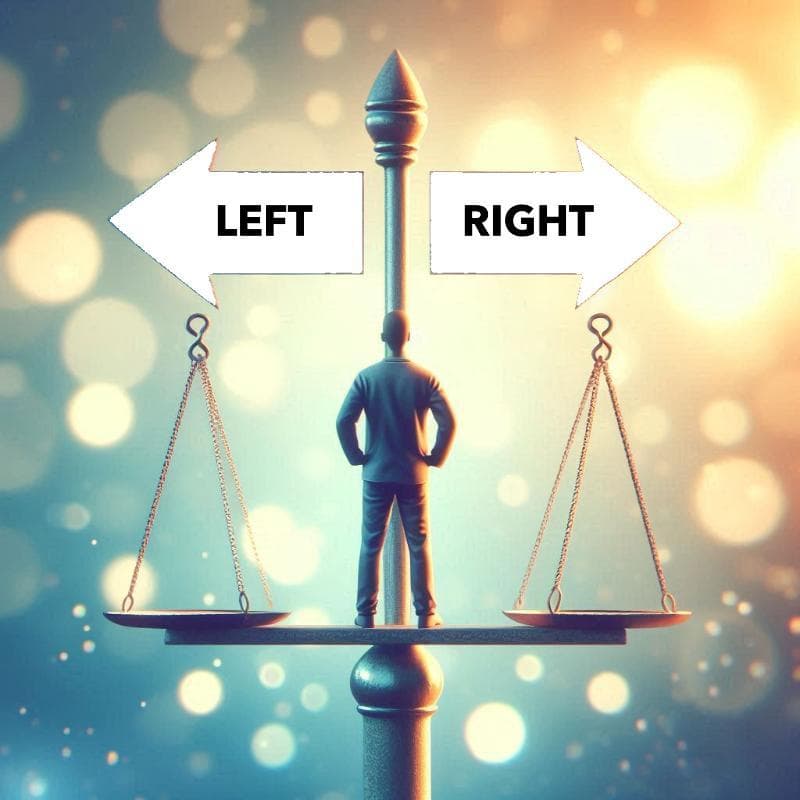Difference Between Left and Right in Political Ideologies

Published on: (Updated on: )
Understanding Political Ideologies: Left vs. Right
Politics can sometimes seem confusing, but it's important to have a basic understanding of the different political ideologies that shape the world. The most common way to represent these ideologies is along a spectrum that ranges from left to right. This article will break down the characteristics, values, and examples of both the left and the right in a way that’s easy to understand.
The Political Spectrum
Imagine a line stretching from left to right.
- Left: Represents more progressive or liberal ideas.
- Right: Represents more conservative or traditional ideas.
Sometimes, you’ll hear about the far left and far right, which refer to the extreme ends of this spectrum.
Understanding the Left
The left side of the political spectrum is often associated with the following beliefs:
- Social Equality: The left advocates for social justice, focusing on issues like racism, sexism, and LGBTQ+ rights. They believe that everyone should have equal opportunities, regardless of their background.
- Government Intervention: Left-leaning policies often support a more active role for the government in the economy. This can include things like raising the minimum wage, providing universal healthcare, and implementing strict regulations on businesses to protect the environment.
- Welfare Programs: Many on the left believe in providing support for the less fortunate, including programs like food assistance, unemployment benefits, and public education. The idea is that society should help those in need.
- Progressive Taxes: People on the left typically support higher taxes on the wealthy to help fund social programs and reduce income inequality. They argue that those who have more resources should contribute more to the common good.
- Global Perspective: The left often supports international cooperation, including efforts to combat climate change through global agreements. They are generally more open to immigration, arguing that diversity strengthens society.
Examples of Political Groups Often Considered as Left-Wing:
- Democratic Party in the United States
- Labour Party in the United Kingdom
- Social Democratic parties in various European countries
Understanding the Right
The right side of the political spectrum is often associated with these beliefs:
- Individual Responsibility: The right emphasizes personal responsibility and the belief that individuals should have the freedom to make their own choices without excessive government interference. This includes a strong focus on hard work and self-sufficiency.
- Limited Government: Right-leaning ideologies typically advocate for a smaller government role in the economy. They believe that free markets and competition are the best ways to promote growth and innovation.
- Traditional Values: The right often emphasizes traditional family structures, religious values, and cultural norms. This can manifest in support for laws that reflect these values, such as opposition to same-sex marriage in some contexts.
- Nationalism: Many on the right place a strong emphasis on national identity and sovereignty. This can lead to skepticism about immigration, international agreements, and globalism, as they prioritize their nation's interests.
- Economic Freedom: Those on the right generally support lower taxes, fewer regulations, and less government intervention in the economy. They argue these policies lead to job growth and overall prosperity.
Examples of Political Groups Often Considered as Right-Wing:
- Republican Party in the United States
- Conservative Party in the United Kingdom
- Various nationalist parties in Europe and around the world
The Far Left and Far Right
While the left and right represent the broadest categories, there are extreme versions known as the far left and far right:
- Far Left: This includes ideologies like communism and anarchism, which advocate for radical change in society, often seeking to abolish capitalism entirely and promote complete social ownership or communal living.
- Far Right: This can include fascism and extreme nationalism, often characterized by authoritarian governance, anti-immigration policies, and a strong emphasis on maintaining traditional societal structures, sometimes at the expense of individual rights.
Real-World Application
Understanding these ideologies can help you navigate current events, social issues, and political debates. Here are some questions to reflect upon:
- How do these ideologies shape public policy? Consider things like healthcare, education, and environmental protections.
- Why do people align with one side over the other? Think about personal experiences, social background, and values.
- What are the consequences of extreme beliefs? Consider how far-left or far-right ideologies can lead to societal division or conflict.
Conclusion
The political left and right represent different perspectives on how society should be structured and governed. The left focuses on equality, social justice, and government support, while the right emphasizes individual responsibility, traditional values, and economic freedom. By understanding these ideologies and their implications, you can become a more informed citizen and participate more effectively in discussions about the world around you.
You might also be interested in the meaning of 'Woke Mind Virus'.